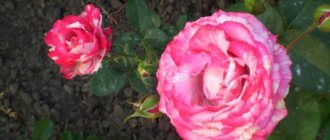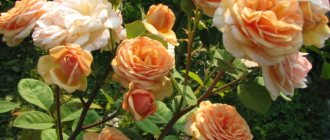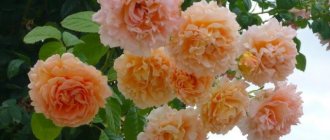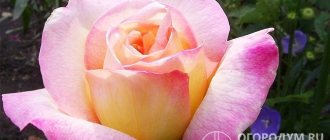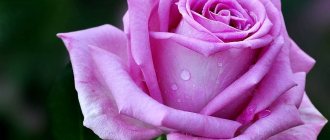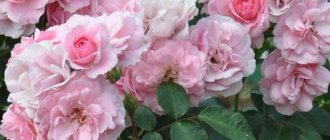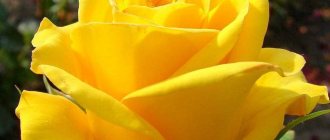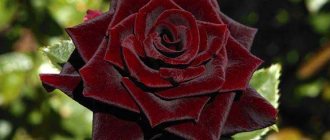Rose William Shakespeare and William Shakespeare 2000 (William Shakespeare, William Shakespeare 2000, AUSromeo)
The William Shakespeare rose, as it is sometimes called, was first introduced to florists in 1987. It is a spreading bush up to 120 cm high. The leaves are dark green. Even during the dormant period, when there is no flowering, it decorates the garden.
In 2000, the rose Shakespeare William 2000 was bred. The flower differs from the primary version in that its petals are painted a carmine shade of red, which turns into lilac. Rose William 2000 Shakespeare is characterized by resistance to diseases and pests, it has a more branched bush.
Brief description, characteristics
Description of the climbing rose Shakespeare:
- the buds are large, up to 15 cm in diameter;
- the shape of the bud is cup-shaped, when opened it becomes flatter;
- bush width - up to 100 cm;
- the aroma is pronounced, alluring, aristocratic in English;
- The color of the petals is a velvety shade of red.
Advantages and disadvantages of the variety
The flower has many benefits that have made it so popular among gardeners:
- long flowering;
- frost resistance;
- the splendor of the bush;
- active and rapid growth;
- strong, pleasant aroma;
- ease of care.
The flower has practically no disadvantages. The only thing you need to pay attention to is that the rose does not like heavy and prolonged rains.
Use in landscape design
The plant is great both solo and in combination with other flowers and plants in flower beds, rose gardens and private areas. It looks best in combination with the following colors:
- aconite;
- delphinium;
- phlox;
- sage;
- bells;
- geranium;
- Veronica.
In the garden, the flower is planted not only in open ground, but also in tubs and flowerpots that are placed at the entrance to the house, veranda, or gazebo. Due to the height of the bush and its width, the rose can be formed into a hedge.
Additional Information! Flowering is wavy and continues throughout the season, until the end of August. In warm autumn weather and temperatures not lower than +6 °C, the rose will bloom until the end of September, beginning of October.
Diseases, pests and ways to combat them
Possible diseases:
- Powdery mildew - cut and burn damaged branches, treat the bush with 30% copper sulfate.
- Rust - remove damaged parts, spray with a decoction of wormwood or nettle, or treat with copper sulfate.
If aphids appear on the bushes, they are sprayed with a solution of laundry soap. If it doesn't help, treat with pesticides.
It is not for nothing that the rose is called the queen of the garden. Its purple bloom is mesmerizing, and its exquisite aristocratic aroma is intoxicating. A bonus to such splendor is easy care and the flower’s resistance to diseases and pests.
History of flowers
The history of the appearance of flowers goes back to ancient times. In the 50s of the 20th century, David Austin first saw old varieties of roses. He was so inspired by the sight of these plants that he decided to create new flowers that would look like the old bush roses. However, David sought to preserve the aroma and delicate beauty of the buds. Old varieties of roses did not have yellow and orange flowers, and Austin wanted to correct this.
By crossing the Belle Isis and Le Grace varieties, the breeder got the first flower, whose name was Constance Spray. This rose turned out to be very beautiful, had a peony-like shape and a delicate aroma. But, to Austin's great regret, this flower bloomed only once, and this was very disappointing for the breeder.
David did not stop, and 23 years after the first attempt, he presented to the public another 50 new varieties, which he developed by crossing different types of English roses. He grafted the plants onto rose hips, crossed them with hybrid tea roses and other flowers. The scent of flowers was very important to Austin, so he paid special attention to this criterion.
This is interesting: Rose scrubs: what are they and why are they so popular
Today, David Austin is one of the most successful plant breeders, selling more than 4 million seedlings a year.
Use in landscape design
The variety grows widely and densely, it is branched, so it is excellent for implementing various ideas within the framework of landscape design. An entire alley of these roses or a rose garden will look most . Also, William Shakespeare goes well with other garden plants, which makes it possible to create different compositions, for example, with:
phlox;
- sage;
- aconite.
If you mark the rose bush in the center, then on the sides and in the foreground you can plant:
- bells;
- primrose;
- or geranium.
Looks great when grown in a container.
Growing a flower, how to plant it correctly in open ground
Growing roses is not difficult; even a beginner can do it. Planting is carried out with seedlings. The best time for planting is from April to May.
Selecting a location
Rose William Morris - characteristics of culture
English rose William Shakespeare loves places with diffused light. Direct sunlight should be avoided. There should be no drafts or strong winds where the bushes are placed. It is recommended to plant seedlings on a small hill.
How to prepare the soil and flower for planting
Traditional preparation of seedlings:
- the roots are buried in water for 4 hours, a little growth stimulator can be added to the liquid;
- shoots are cut to 1/3 of their length, the cut is made at an angle of 45° towards the upper bud.
The drainage mixture is added to the prepared holes:
- 2 parts of fertile land;
- 3 parts manure;
- 2 parts sand;
- 1 part peat.
The size of the holes for planting English aristocratic roses is 40*50 cm.
Step by step landing procedure
When the holes are ready, planting is carried out:
- Carefully untangle the root system.
- Lower the seedling into the hole along the entire length of the roots.
- Sprinkle with soil and compact slightly around the bush.
- Water thoroughly and then spud up.
Attention! If the soil is light, the seedling grafting needs to be deepened by 4 cm, if the soil is heavy - by 7 cm.
Creating conditions for growth
The rose variety William Shakespeare adapts well to central Russia. Summer heat up to 30 o C is tolerated normally, which cannot be said about the 1987 variety, which does not like changes in climate and temperatures above 23 o C. The second version of the Shakespeare rose, in addition to the heat, winters down to -25, but with shelter in a snowless winter.
Lighting requirement
The abundance and brightness of flowers indicate the plant’s light-loving nature. The longer the rays are exposed to the rose, the better. The ideal place is one that provides access to light around the entire circumference of the bush.
It is desirable that there are no buildings or fences nearby; if this is not possible, it is better to choose the south-eastern side.
Despite its love for open, all-round terrain, drafts are not desirable for the William Shakespeare rose. A building can serve as protection from the wind, but only at a distance of a couple of meters.
Soil for roses
It is necessary to avoid the proximity of groundwater; stagnation of moisture and its excess are undesirable. The preferred soil composition is loamy, containing humus. If the place is sunny with underground water or in a low area, it is better to lay a good drainage layer in the roots. In normal soil conditions, drainage is not necessary.
Description of rose variety William Shakespeare and photographs
William Shakespeare is a representative of English roses, created by breeders by crossing hybrid tea varieties with the floribunda group. Thanks to this combination, this type of rose inherited from its ancestors a variety of colors, duration of flowering, special charm and aroma of a spherical flower.
A group of English roses glorified the name of breeder David Austin. Almost all varieties of Austin roses have gained popularity. William Shakespeare is one of the most popular varieties.
The park rose William Shakespeare was presented to flower growers in 1987 and immediately won their hearts. This tall, up to 120 centimeters, powerful, erect bush, covered with dark green leaves, can decorate any corner of the garden even without flowers.
This is interesting: Rose Jubilee Celebration - growing "ostinki"
A little later, in 2000, a new variety was bred - rose William Shakespeare 2000. This variety differs from the original version in its carmine-red flower, turning into a lilac shade, increased resistance to pests and diseases, and a more branched bush.
William Shakespeare blooms with huge, 12-15 centimeters in diameter, deep red flowers with pinkish tints. One bud contains more than a hundred double petals, so the cup-shaped flower does not show a yellow center even when fully bloomed.
The rose exudes a delicate, classic aroma of old roses with light notes of violet. Flowering continues all summer, in waves. After a short break in August, the rose can bloom again in September if the weather is warm.
Rose William Shakespeare has average resistance to frost, so it must be carefully covered for the winter. The rose is also moderately resistant to diseases.
David Austin's advice on pruning English roses
Pruning roses is a very important procedure, on the correctness of which both normal wintering and the further development of the plant depend. In 1996, David Austin published a book in which he talked about how to properly prune roses bred in his nursery. According to the master’s recommendations, you need to focus on the shape of the bush:
- “stalks” of a wide-spreading form are cut off by a third of the length of the shoots in the fall;
- medium-sized English roses with erect shoots are cut to a third of the length of the shoots;
- vigorously growing “stalks” with erect shoots are cut to half the length of the shoots;
- English roses with arched drooping shoots are pruned to a fifth of the length of the shoots.
Since roses of the varieties William Sheakespeare and William Sheakespeare 2000 have erect shoots, their autumn pruning should be done to a third of their length.
Plant care
William Shakespeare is a rather unpretentious rose that does not require the creation of specific conditions for its maintenance.
- Watering rules and humidity
Rose Lady Bombastic (Miss Bombastic) - characteristics of a spherical bush
Water in spring and autumn - once a week, in the summer heat - every 3 days. The volume of water for the bush is 10 liters.
Watering is carried out in the morning or evening. When the water is absorbed, the soil needs to be loosened.
Attention! Stagnation of water should not be allowed, because increased soil moisture will lead to rotting of the roots.
- Fertilizing and soil quality
The rose grows quickly, so it needs regular feeding. The first fertilizer is applied in the spring, when young branches begin to form. For feeding, manure or complex mineral fertilizers are used.
In summer, fertilizers should be used every 2 weeks from spring until the last days of July. At the same time, organic matter and minerals are alternated.
To stop the process of growing branches, potassium monophosphate is added to the soil in the fall. The product will help the rose endure winter more easily.
- Pruning and replanting
Cleaning pruning is carried out in the spring. Bad and weak shoots that did not survive the winter well are removed.
This is interesting: Why do rose leaves turn red?
To give the rose a bush shape, it is necessary to periodically cut off the thickest branches. After each flowering, faded buds are removed.
If it is necessary to transplant the bush to a new place, it is carefully dug up, leaving a lump of old soil on the roots. The plant is transplanted into fertile soil and watered abundantly.
- Features of wintering a flower
With the onset of the first frost, the lower branches need to be covered with sand or earth to protect the roots. Unripe shoots are cut off.
It is necessary to make a frame over the bush, on which a non-woven fabric is thrown. The rose needs to be covered with 2-3 layers of fabric. Additionally, cover with spruce branches to create an air cushion.
Attention! During the winter thaw, the lower part of the shelter needs to be raised to give the rose access to fresh air. If the inside of the rose overheats, bacterial cancer may develop.
Landing Features
Rose variety William Shakespeare loves warmth and light. It should be planted in a brightly sunny area, but at the same time it should be reliably protected from gusts of wind and drafts. The ideal place for planting would be a slight elevation. This way you can prevent waterlogging of the soil.
For planting, prepare a hole with dug up garden soil, which is filled with rotted manure (half a bucket), wood ash (1 cup) and a mixture of mineral fertilizers for roses or flowering plants (200 g). The diameter of the pit is about sixty centimeters, the depth is no more than half a meter.
If you plan to plant several bushes, the distance between them should be at least a meter.
Preparing for winter
This variety is not able to safely overwinter without proper shelter . That is why, at the first frost, you need to take care of how to protect your roses. The root collar must be covered with dry soil with humus and a hill about forty centimeters high must be made.
You need to build a kind of wire frame over the plant, and at the first frost, covering material is thrown over this frame, and it needs to be well fixed to the ground.
The material should be quite durable and the rose should be covered in several layers. You can create an air cushion from spruce branches.
During winter thaws, it is necessary to ensure ventilation of the shelter; for this, you can slightly raise the shelter. Overheating of the plant can lead to decay and even infection with bacterial cancer.
The winter shelter is removed gradually when spring comes. When warm weather arrives, you can first remove the spruce branches and mulch. The frame is not removed and the covering material is thrown over it again. You can finally remove the shelter only when the snow has completely melted. With this option of removing the winter shelter, the plant will not suffer from active sunlight, which can burn it.
By the way, polystyrene foam serves as an excellent covering material. You can use it to make unique caps that will retain heat inside and protect the rose from moisture.
Hit parade of red roses David Austin
The English rose heads our podium
Darcey Bussell (David Austin 2006, Ausdecorum)
Title: Darcey Bussell (Darcey Bussell) David Austin, 2006, Ausdecorum). The rose is named after the English ballerina, actress, and singer.
Description: English Rose 'Darcey Bussell' boasts an abundance of fully double, rich dark red flowers with a pleasant fruity aroma with a hint of fresh greenery. Some describe the color as that of ripe raspberries.
'Darcy Bussell' is compact and low growing, averaging three to four feet in height. Repeated flowering. Increased resistance to diseases, does not wilt from rain. USDA winter hardiness: zone 6.
Bush of medium height, with strong shoots. 80-100 cm in height and 60 cm in width.
Award “Award of Garden Merit” 2012. You can buy seedlings in any online store. The price of a 2-year-old seedling starts from $25.
Munstead Wood (David Austin 2007 Ausbernard) Munstead Wood
Re-blooming rose-spruce. Approximately 80 petals in one bud. The flowers of this variety are actually light crimson in the bud, but as the center gradually opens itself, it becomes a very deep velvety crimson. The blooming flowers are large and beautiful, forming a very full, packed rosette.
The foliage of Munstead Wood is quite dense, forming a wide bush with good disease resistance. The leaves are medium green, younger ones are reddish-bronze, creating a nice contrast.
Strong old rose scent with a fruity note. Ausbernard aroma expert Robert Culkin describes it as "a warm and fruity blend with blackberries, blueberries and sloe."
Munstead Wood is a famous British manor house with a botanical garden created by Gertrude Jekyll in Surrey.
Bush size: 4 feet tall by 3 feet wide. Hardiness: USDA zones 5-9. Award of Garden Merit.
William Shakespeare 2000 (David Austin 2000 Ausbernard)
Title: William Shakespeare 2000
Description: The English rose 'William Shakespeare 2000' is a truly superb variety with exquisite flowers of a rich velvety crimson color, gradually turning into an equally rich purple.
At first, the petals are deeply planted, gradually opening and dividing into small quaternary cups.
This rose has a strong, warm old rose scent that can be expected but not always found in deep red roses. The variety is very hardy and is especially successful in areas with drier climates.
Repeated flowering. Grows up to 4 feet tall and 3 feet wide.
Thomas a Becket - David Austin English Rose
The English rose Thomas Becket bears the name of the Archbishop of Canterbury, canonized by the Catholic Church 1162-1170.
This beauty is very different from other English roses. The rose “Thomas à Becket” has unusual medium-sized buds, collected in clusters of 3-5 pieces.
The bush is 120 cm tall and 90 cm wide.
Flowering begins in early summer, a week or two later than most roses. But soon the bush comes to life, producing a mass of flowers. The unusual red color develops in such a way that it is difficult to describe or even photograph. It starts out light red, then pours to a carmine red. The aroma is old rose with strong lemon zest.
Looks impressive in combination with geranium, verbena and other perennial plants, as well as flowering shrubs. This variety is best used where shrub is desired. This is a particularly strong and useful variety that can tolerate some shade.
Details: re-blooming. The double flowers are 4 inches in diameter with approximately 65 petals each. Grows to 4 feet tall and 3 feet wide or more depending on pruning. Recommended in USDA zones 5-9.
Tam o Shanter - David Austin Roses
The wide bush is healthy and strong. Grows up to 6ft x 5ft. Recommended for growing in USDA zones 5 - 9.
The variety was named in honor of the 250th anniversary of the birth of Scottish poet Robert Burns. Tam O' Shanter is the subject of one of Burns's most famous poems, although today the name is most often associated with a type of Scotch hat. In the poem, Tam stays too long in the tavern after market day, and, drunk on ale, returns home at night. While driving home through creepy places, he encounters witches, skeletons, and the grisly dead rising from their coffins. Filled with fear, he screams and runs for his life. And just in time, he leaps to safety, but not before the most beautiful witch flies off the tail of his horse.
For the last time, gathering her strength, the good mare rushed, flew up onto the creaky bridge, leaving a gray tail for the devils. Robert Burns Translation: S. Ya. Marshak
What associations did you have when contemplating this rose?
Falstaff - David Austin English Rose
Title: Falstaff - David Austin, English Roses.
The English rose Falstaff is named after the Shakespearean hero, companion of King Henry. The variety was bred by David Austin in 1999; in 2004, the rose was awarded a test certificate from the Adelaide competition in Australia.
Description: Gorgeous, cupped, very full petaled flowers in a deep deep crimson color that take on the most pleasing shade of deep purple. Has a powerful old rose scent.
The bush has strong vertical shoots. It grows to 4 feet tall and 3 1/2 feet wide. The rose tends to produce long branches and can be cultivated in the garden as a small climber. It is propagated by cuttings and by dividing the bush (the fastest ways to get a new bush of this variety). If poorly cared for, it is susceptible to attacks by diseases and pests.
Heathcliff - David Austin English Rose 2012
Name: Heathcliff - David Austin English Rose Description: English rose 'Heathcliff' - there are few roses as popular as the deep crimson colors and none of which are as difficult to breed 'Heathcliff' has large, fully double flowers in the form of a rosette. The color is really deep crimson, with a certain softness that is reminiscent of some of the old red Gallica roses.
It is a healthy variety with shiny dark green leaves and an upright growth habit. Its beautiful aroma is unusual: tea rose infused with old rose blends beautifully with light notes of earthy, elegant, dry woody cedar. Approximately 105 petals per flower.
Grows to 3 1/2 feet tall x 3 feet wide.
Tess of the Urbervilles - David Austin 1998
Name: Tess of the d'Urbervilles - David Austin English Rose Description: The English rose 'Tess of d'Urbervilles' has large, bright dark red flowers with a beautiful, deeply cupped shape. The edges of the inner petals are curved inside the flower, the bud is densely double (75-80 petals). This is an excellent repeat flowering variety, full of buds from early summer until frost.
The medium-heavy old rose scent is lovely. This is an excellent rose for cutting and bouquets. The bush grows to 4 feet tall by 3 1/2 feet wide, or 6 to 8 feet when formed as a polyantha.
David Austin's red English roses will be appropriate in any landscape style, be it classic French or English landscape, rural country or sophisticated modern. They are so hardy that they can be content with a container and decorate a balcony, veranda or winter garden.
